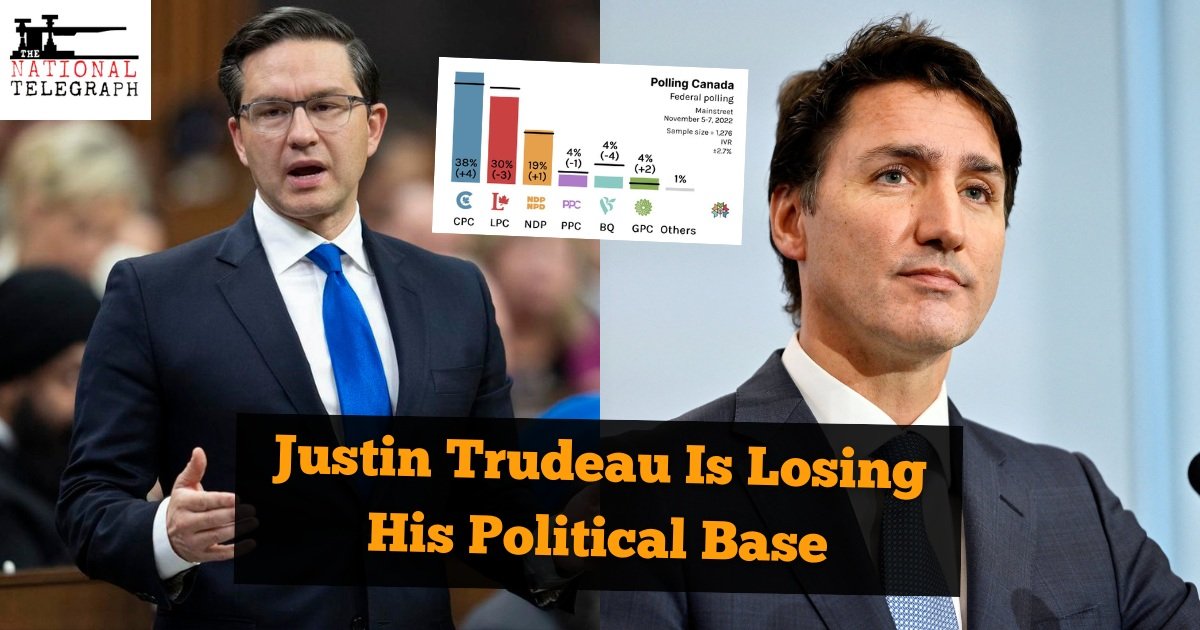Written By Wyatt Claypool, Posted on November 13, 2022

Since Carlton MP Pierre Poilievre was elected as the new Conservative Party leader the CPC has taken a significant lead over the Liberals in polling, but it is the Liberals’ polling specifically that demonstrates why Prime Minister Justin Trudeau’s days in office may be numbered.
Justin Trudeau has remained prime minister after two elections in a row where his party was beaten by the Conservatives in the raw vote, but a Mainstream Research poll released a few days ago, commissioned by iPolitics, shows Trudeau underperforming with key demographics that helped him overcome the Liberal vote deficit in the past.
When Andrew Scheer and Erin O’Toole beat Trudeau in the popular vote but failed to become prime minister, it was mainly due to their vote being heavily concentrated in Western Canada and rural ridings, and losing the female vote, despite having a large lead with men. Conversely, Justin Trudeau could count on areas like the GTA, Vancouver metro, and Montreal to deliver him a large portion of his seats because he brought in large portions of female voters and older voters while keeping a tight margin with the Conservatives and NDP when it came to younger and middle-aged voters.
(Photo from The Huffington Post)
Now with Poilievre leading the CPC, after an energetic leadership race, and issues like inflation and voters fatigue with Liberals’ tax and spend tendencies and climate fixation, those demographics Trudeau relied on since 2015 for electoral success are abandoning him fast.
In Mainstreet’s poll in July of 2021, the Liberals commanded 35 percent of female voters, 34.4 percent of voters aged 50-64, and 43.5 percent of voters 65+, while still winning 28.8 percent of voters aged 35-49, while O’Toole’s Conservatives only had an advantage with 29.6 percent.
Mainstreet’s polling in November 2022, Trudeau’s Liberals now only take 27.4 percent of the female vote, 25.6 percent of voters 50-54, 33.8 percent of voters 65+, and 25.6 percent of voters 35-49.
Poilievre’s Conservatives narrowed Trudeau’s lead with women to only 0.1 percent, jumped far ahead with voters 50-64, reduced the gap on voters 65+, and took a 13 percent lead over the Liberals with voters in the 35-49 age demographic.
This is catastrophic for the Liberals seeing as Conservatives already lead heavily with male voters (41.3 percent) and now lead with voters 35-49 and 50-64 which are the two biggest age brackets of voters by far, and the most likely to turn out to vote in elections.
(The below polling graphic takes into account undecided voters who are leaning in one parties direction or another)
Federal Polling:
CPC: 38% (+4)
LPC: 30% (-3)
NDP: 19% (+1)
PPC: 4% (-1)
BQ: 4% (-4)
GPC: 4% (+2)
Others: 1%Mainstreet Research / Nov 7, 2022 / n=1234 / MOE 2.7% / IVR
(% Change With 2021 Federal Election)
Check out federal details on @338Canada at: https://t.co/PH3p7jMoLI pic.twitter.com/lnepigmLGP
— Polling Canada (@CanadianPolling) November 11, 2022
The recent polling by Mainstreet and other pollsters doesn’t just show the Conservatives have a chance to win a majority if another election was held in the near future, but that the Liberals have demographic barriers to catching up in the polling.
Simply put, Justin Trudeau no longer has a reliable demographic of voters to lean on, and it’s not entirely because the CPC and NDP are taking large portions of their support in those key demographics, but that a large portion of previously Liberal voters is now undecided and unlikely to show to vote.
Wyatt is a student at Mount Royal University, where he is the president of its Campus Conservative club. In his writing, he focuses on covering provincial and federal politics, firearms regulation, and the energy sector. Wyatt has also previously written for The Post Millennial.
Very well presented. Every quote was awesome and thanks for sharing the content. Keep sharing and keep motivating others.